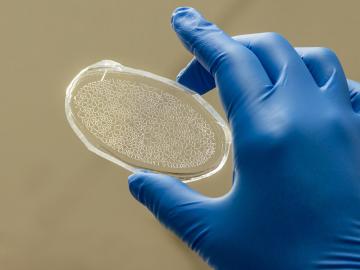
Filter News
Area of Research
- (-) Biology and Environment (66)
- (-) Materials (55)
- Advanced Manufacturing (3)
- Biological Systems (2)
- Computational Biology (2)
- Computational Engineering (1)
- Electricity and Smart Grid (1)
- Energy Science (43)
- Functional Materials for Energy (1)
- Fusion and Fission (11)
- Fusion Energy (8)
- Isotope Development and Production (1)
- Isotopes (10)
- Materials for Computing (4)
- National Security (7)
- Neutron Science (34)
- Nuclear Science and Technology (21)
- Nuclear Systems Modeling, Simulation and Validation (1)
- Quantum information Science (2)
- Supercomputing (67)
News Topics
- (-) Advanced Reactors (4)
- (-) Bioenergy (52)
- (-) Biomedical (20)
- (-) Frontier (6)
- (-) Physics (29)
- (-) Space Exploration (2)
- 3-D Printing/Advanced Manufacturing (27)
- Artificial Intelligence (15)
- Big Data (11)
- Biology (74)
- Biotechnology (14)
- Buildings (5)
- Chemical Sciences (36)
- Clean Water (14)
- Composites (11)
- Computer Science (34)
- Coronavirus (14)
- Critical Materials (13)
- Cybersecurity (5)
- Energy Storage (37)
- Environment (102)
- Exascale Computing (6)
- Fusion (8)
- Grid (8)
- High-Performance Computing (24)
- Hydropower (8)
- Irradiation (1)
- Isotopes (13)
- ITER (1)
- Machine Learning (12)
- Materials (78)
- Materials Science (82)
- Mathematics (4)
- Mercury (7)
- Microscopy (34)
- Molten Salt (3)
- Nanotechnology (42)
- National Security (5)
- Neutron Science (36)
- Nuclear Energy (16)
- Partnerships (13)
- Polymers (18)
- Quantum Computing (3)
- Quantum Science (11)
- Security (3)
- Simulation (16)
- Summit (11)
- Transportation (15)
Media Contacts

Nine student physicists and engineers from the #1-ranked Nuclear Engineering and Radiological Sciences Program at the University of Michigan, or UM, attended a scintillation detector workshop at Oak Ridge National Laboratory Oct. 10-13.

Laboratory Director Thomas Zacharia presented five Director’s Awards during Saturday night's annual Awards Night event hosted by UT-Battelle, which manages ORNL for the Department of Energy.

Tomás Rush began studying the mysteries of fungi in fifth grade and spent his college intern days tromping through forests, swamps and agricultural lands searching for signs of fungal plant pathogens causing disease on host plants.

ORNL researchers are deploying their broad expertise in climate data and modeling to create science-based mitigation strategies for cities stressed by climate change as part of two U.S. Department of Energy Urban Integrated Field Laboratory projects.

Researchers at ORNL explored radium’s chemistry to advance cancer treatments using ionizing radiation.

Researchers at the Department of Energy’s Oak Ridge National Laboratory and their technologies have received seven 2022 R&D 100 Awards, plus special recognition for a battery-related green technology product.

Scientists at ORNL have created a miniaturized environment to study the ecosystem around poplar tree roots for insights into plant health and soil carbon sequestration.

ORNL Corporate Fellow and Center for Nanophase Materials Sciences researcher Bobby Sumpter has been named fellow of two scientific professional societies: the Institute of Physics and the International Association of Advanced Materials.

Chemical and environmental engineer Samarthya Bhagia is focused on achieving carbon neutrality and a circular economy by designing new plant-based materials for a range of applications from energy storage devices and sensors to environmentally friendly bioplastics.
Scientists at Oak Ridge National Laboratory are closer to unlocking the secrets to better soil carbon sequestration by studying the tiny, sand-like silicon deposits called phytoliths in plants.


